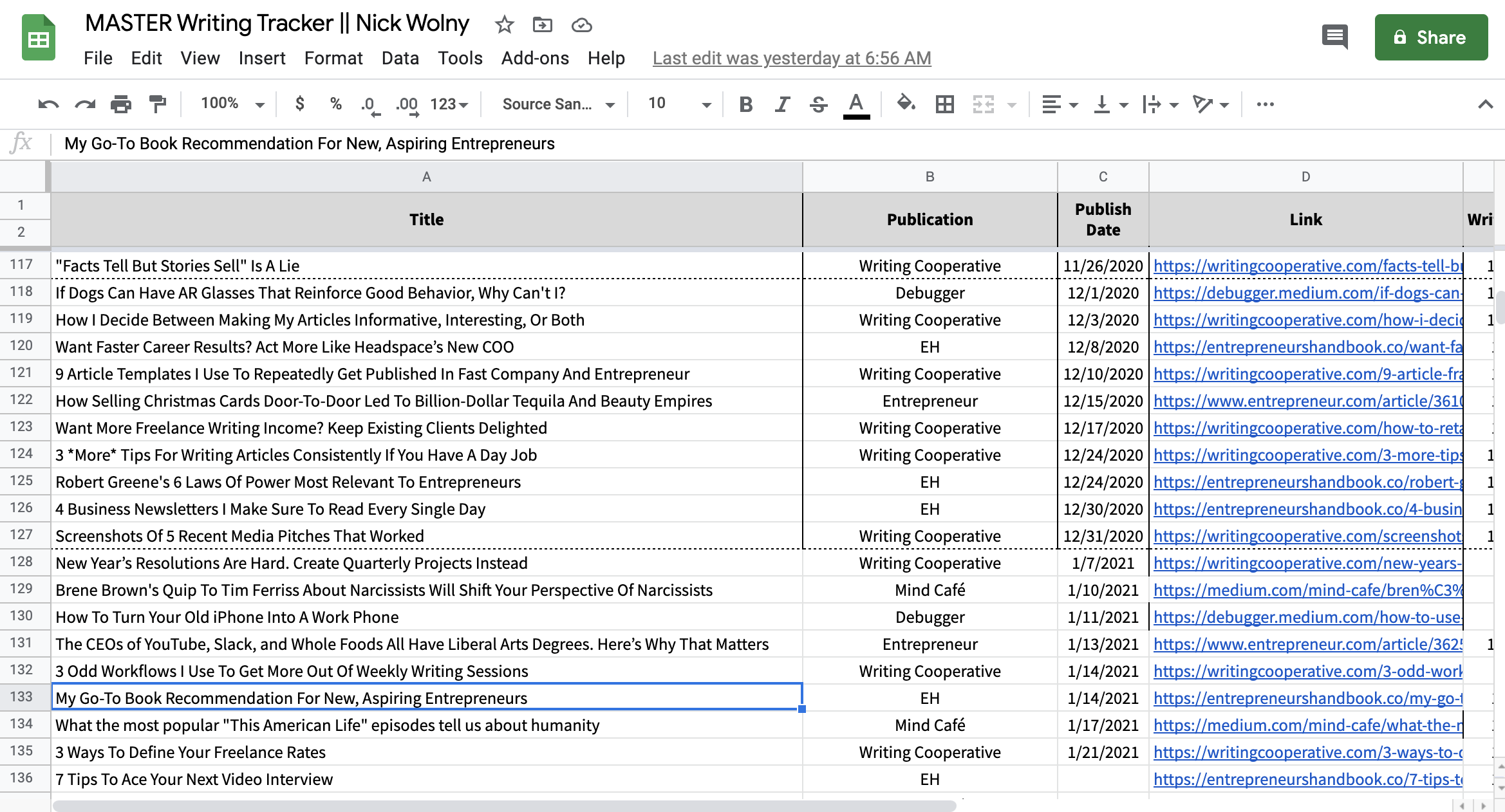BUSINESS WRITING EXAMPLES: 5 WAYS I USE WRITING IN ONLINE BUSINESS

How much written content is actually needed to market and operate an online business? If you want to sell your services as a writer, content creator, or entrepreneur, what should you prioritize and what can you ignore? In a typical work week I chug away on five different categories of writing, and in this article I’ll run through business writing examples for each of them in a little more detail.
Sometimes it’s better to spend your time promoting your services or work ahead on the projects you have with clients, and other times your best next step is to write articles, help your readers, and have them learn a little more about who you are and what you do. It can also be helpful to see how other writers set up their work week.
These categories exclude actual client writing itself. Some of you write for a living, whether it be hundreds of snappy social media captions or a single ghostwritten memoir. Others don’t sell writing at all, but want to leverage writing to promote a product, program, or service. In either case, you’re in the right place.
Business writing examples: Why write online, and why do it now?
Writers, experts, and content creators face a unique landscape of circumstances at the moment. Here are a few statistics to note:
E-learning will be a $325 billion industry by 2025
People want to consume information online and they’re happy to pay for it. This metric is from 2018 — long before quarantine forced millions of creators to pivot into all-online offerings — so the true projection is probably higher. If you’ve ever wanted to sell your services, programs, or products online, now is a really good time to get started.
58% of marketers think written content is best
According to survey results collected by Social Media Examiner, 58% of professional marketers feel that original written content is more valuable than image or video content. What I found interesting about this statistic is that these survey respondents are the people responsible for getting a return on investment from marketing expenditures. If they find writing more valuable and worthwhile than video (Which seems to get all the love these days), that’s something for us to pay attention to.
“58% of professional marketers feel that original written content is more valuable than image or video content.”
Online media consumption is 12+ hours a day
As I’ve mentioned before, reports from Nielsen saw Americans were spending over 12 hours a day consuming media, and that was in Q1 2020, which only had a few weeks in lockdown. Screen time is shattering records left and right as we ride this out together online; this is a window of opportunity for anyone aspiring to have an online side hustle or business to reach more people than usual.
What does it all mean? These statistics, when presented together, present the case that the time is now to prioritize writing online. But what should you work on, and when?
It depends. My approach is one of many options, but you may find it helpful. So here are the five buckets I categorize my writing efforts into each week.
Business writing example #1: Content writing
Percentage of my writing week: 50%
I recently pivoted my business model from 1-on-1 services to on-demand programs and products. My company still handles clients who want content marketing done for them, but otherwise it’s just me, my keyboard, and a dream. The goal is to help as many creators and entrepreneurs as possible, so to achieve that I needed to expand my offerings.
My audience is small, so at this time content writing in the form of articles or long-form blog posts is a big priority for me. Content writing is critical because it helps readers get to know a little more about me and decide whether or not they want to download a freebie from me at the end of an article and join my email list. My email list is where all the action is, so it’s almost like my articles are little billboards for my list.
Articles create views and traffic, and for a business model like mine you can’t grow if there’s no traffic. To pump out the content, my writing muscles (And brain) need to stay strong and in shape. Otherwise, it takes an eternity to get anything published. Work to hone your writing craft each and every week and the content creation process will get easier over time.

Screenshot from author. Tracker for content writing and articles.
Business writing example #2: Email copywriting
Percentage of my writing week: 20%
As some of you probably know, I’m a big fan of email and email marketing. Email lets you directly communicate with your audience and helps you repurpose your writing or send old articles to new readers. Email also lets you be scrappy; you don’t need to obsess over design, images, or graphics for your efforts to be effective.
One of the biggest mistakes of my career was not growing or maintaining my email list when my client book was full. And there’s a reason social media enthusiasts sometimes shun email: It’s harder.
The average worker gets 121 emails a day, and here you are, asking them if they would like more emails. To have someone on your email list means they really want to hear from you. I like the idea of having all my people who really want to hear from me in one corner of the internet, personally.
I spend most of my time in email dashboard working on either a weekly newsletter or tweaking various automations. If I run a sales promotion, or if someone buys something from me… that’s all automated, which sounds nice, but I have to write all the material that will go into said automations first. Automations take time, but are worth it.

Screenshots from the author. Automations within an email list.
Business writing example #3: Sales copy
Percentage of my writing week: 10%
I wrote sales copy for years for clients, but never had needed a lot of it for my own stuff because I was usually only selling one prospective client at a time. Now that I’ve shifted to more of a one-to-many model (Selling a more accessible offer to many more people at once), I need sales copy that can help do some of the heavy lifting and question-answering when I’m not around.
Whether it’s a product page or a series of sales emails, sales copy is its own beast. I received a great tip once on the distinction between content writing and copywriting: Content writing is mainly in your voice and about you, whereas copy is mainly in your reader’s voice and all about them.
That being said, sales copy is, well… sales-y. It goes heavy on persuasion, and if you write like that all the time you’ll come across as pushy. I like to compartmentalize this style of writing into its own session. I confess I don’t write sales copy every week, but when I zoom out and look at a 3-month period it comes out to about 10% of my writing time.
Once you’ve written your sales copy once, you don’t need to write it over and over again; just set it and forget it, or make light tweaks along the way.
Business writing example #4: Pitches
Percentage of my writing week: 10%
To land calls with prospective new clients, pursue opportunities for increased exposure, and strike up relationships, you have to pitch. I put pitching in its own category because it is writing that isn’t really meant for a group of readers; pitches are intended for one decision maker, so they need to be fairly customized.
Whether it’s a pitch for a potential proposal, an article pitch, or a pitch for a prospective collaboration opportunity, a pitch doesn’t have to be a lot of meat to it, but it does have to be tight. Instead of trying to message 100 people on LinkedIn with the same old boring stock pitch and getting no responses, slow down and send a few pitches that are truly custom. Your response rate will be way better in the long run.
Business writing example #5: Products
Percentage of my writing week: 10%
Since I transitioned from full-time consulting to a blend of consulting and courses in 2020, I now have another category of content to produce: Content that readers or clients are paying for.
From checklists and course lessons to freebies and outlines, it all adds up. Since I work with subcontractors like designers and virtual assistants to run my online business, I also have what I like to call “setup writing” — explanations of design projects, creation of protocols that a virtual assistant or contractor can follow, and so on.

Screenshot from author. Example of setup writing.
The good news about this writing is that it doesn’t require much creativity, so I can throw on the TV or a podcast while I’m completing these types of writing tasks. If you find yourself going though the same motions over and over again with clients or contractors, consider writing something that can replace your explanatory efforts and save time in the long run.
The bad news is that “just writing an article here and there” isn’t enough to have an online business. But by building up your writing muscles and stamina, it’s more realistic than you think to create a successful side hustle or online gig powered by the written word. Keep yourself inspired, focus on the long game, and you’ll find that writing regularly can take your entrepreneurial pursuits far and wide.

